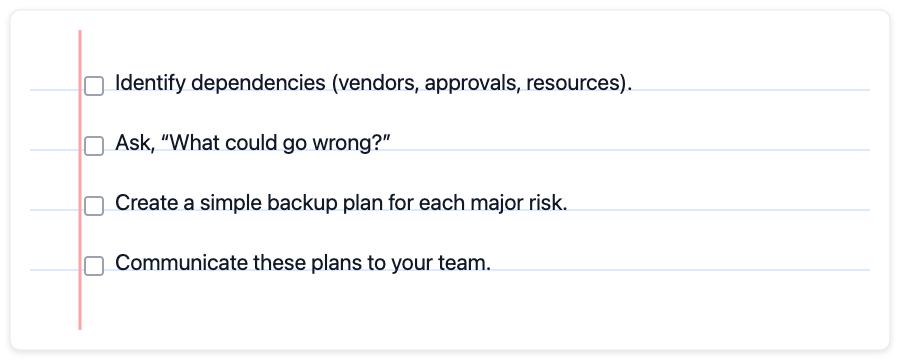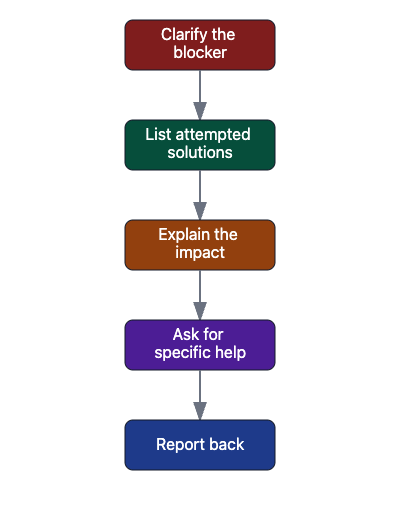Great project leaders don’t just react to problems — they anticipate them and keep the team moving forward. Think of risk management like planning a road trip: you check the weather, map out alternate routes, and pack a spare tire, so you’re ready for whatever comes your way. When you lead with this mindset, your team feels confident that you’ve got their back, even when the unexpected happens.
In this lesson, you’ll learn how to:
- Spot risks early and create backup plans so your team isn’t caught off guard.
- Remove blockers quickly and communicate clearly about what’s happening.
- Engage the right people for help, making your requests clear and respectful.
By the end of this lesson, you’ll be ready to spot risks early, tackle blockers head on, and keep your project moving forward.
Anticipating risks is about thinking a few steps ahead. Regularly review your project plan and ask, “What could slow us down here?” For example, if a key deliverable depends on a vendor who’s missed deadlines before, you might say: “If the vendor is late, we’ll use our backup supplier to avoid delays.” Share these plans with your team so everyone knows what to do if a risk pops up. This proactive approach keeps your project on track and builds trust.
Here’s a quick checklist for risk planning:

Here’s a real-world example of proactive risk planning:
- Jessica: Chris, our project launch depends on getting final approval from the compliance team, and they’ve sometimes needed extra time in the past.
- Chris: Good point. If compliance is delayed, it could impact our schedule.
- Jessica: Exactly. I’ve already sent them the materials early and set up a check-in for Wednesday. If we don’t get approval by then, we’ll proceed with the previous version as a temporary measure. I’ll keep everyone updated so we can adjust quickly if needed.
- Chris: Sounds good. Let me know if you need help following up with compliance.
Jessica demonstrates how to anticipate risks by identifying potential delays, communicating backup plans clearly so everyone knows the next steps, and keeping the team prepared to adapt quickly if things don’t go as expected. This approach helps the team stay confident and focused, even when facing uncertainty.
Blockers are anything that stop your team from making progress. Some instances of blockers include waiting for feedback, missing information, or unclear requirements. When you spot a blocker, act fast.
The CLEAR framework can help you address blockers efficiently and engage the right people for support:
- Clarify the blocker: Clearly state what is stopping progress.
- List attempted solutions: Share what you or the team have already tried.
- Explain the impact: Describe how the blocker is affecting the project or timeline.
- Ask for specific help: Make a direct and respectful request for support.
- Report back: Keep everyone updated on progress and outcomes.

For example, if someone says, “I can’t finish this until I get the client’s feedback,” you might use CLEAR like this:
“The integration is blocked while we wait for the vendor’s API docs (Clarify). We’ve followed up twice and checked their portal for updates (List attempted solutions). Without these docs, our integration work is stalled and could delay the launch (Explain the impact). Could your team help escalate this with the vendor this week? (Ask for specific help). I’ll update everyone as soon as we have a response (Report back).”
Using the CLEAR framework ensures your communication is focused, respectful, and action-oriented, making it easier to get the support you need and keep your project moving.
Sometimes, you’ll need help from outside your team. Be direct and respectful:
“Could your team support us with the migration this week? We’ve tried all internal solutions, but your expertise is critical to meeting our deadline.”
Being transparent about urgency and trade-offs helps others understand why their support matters.
You’ve seen how anticipating risks, acting quickly on blockers, and engaging the right resources can keep your project moving. In the next practice, you’ll get hands-on experience identifying risks, communicating blockers, and collaborating with others to find solutions. These are the skills that will help you lead your next project with confidence, even when the road gets bumpy.
